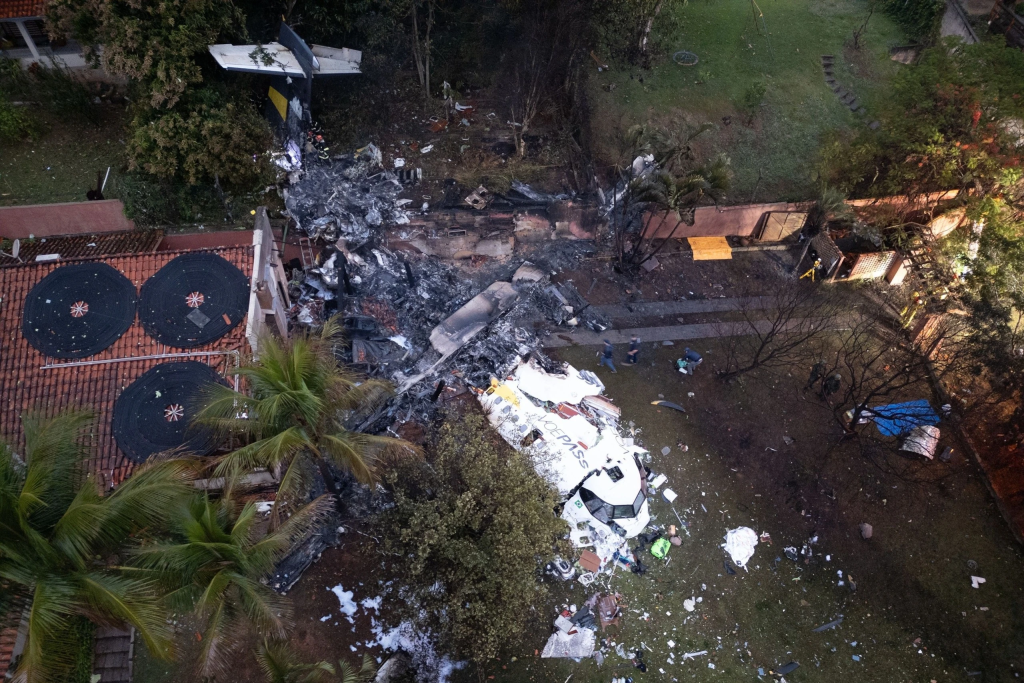The Fatal Flight and Crash Details
The ill-fated flight 2283 was nearing the end of its two-hour journey when it suddenly lost altitude and spiraled out of control, crashing into a residential area. Eyewitnesses in Vinhedo reported hearing a loud rumbling noise as the plane descended, spinning violently before impact. The crash occurred in a grassy area close to residential buildings, but fortunately, no one on the ground was injured.
Videos captured by locals showed the plane spinning in circles as it fell, followed by a massive plume of smoke rising from the crash site. The aircraft’s fuselage was shredded, with debris scattered across the area. The crash resulted in the complete destruction of the plane, with no survivors among the 57 passengers and four crew members.
The Aircraft: ATR 72-500 and Its Infamous History
The aircraft involved in the crash was an ATR 72-500, a twin-engine turboprop manufactured by the French-Italian company ATR. The ATR 72 series is widely used globally, known for its efficiency on short-haul routes. Despite its popularity, the ATR 72 has had a history of accidents, particularly in icy conditions.

The ATR 72-600, a newer model in the series, is often compared to the 500 series. The ATR 72-600 is known for its advanced avionics and higher efficiency. The cost of an ATR 72-600 varies, with new units typically priced around $26 million. Despite its improvements, the ATR 72 series has faced scrutiny, especially regarding its performance in adverse weather conditions.
Potential Causes of The Tragic Crash
While the exact cause of the crash is still under investigation, preliminary data suggests that severe icing may have been a factor. FlightRadar24, a flight tracking service, indicated that there was an active warning for severe icing in the area at the time of the crash. Icing can severely affect an aircraft’s performance by adding weight and reducing lift, making it difficult for the plane to maintain altitude.
Experts have pointed out that icing has been a contributing factor in past crashes involving the ATR 72. In 1994, an ATR 72 operated by American Eagle crashed in Indiana due to severe icing, leading to the deaths of all 68 people onboard. Following that incident, ATR made significant upgrades to the anti-icing systems on its aircraft. However, the possibility of icing remains a concern, especially in severe conditions.
Impact on the Aviation Community
This crash marks the deadliest aviation disaster in Brazil since 2007 and raises serious concerns about the safety of turboprop aircraft in adverse weather conditions. The tragedy has led to an outpouring of grief and support from around the world. President Luiz Inácio Lula da Silva has declared three days of national mourning, urging the nation to support the victims’ families during this difficult time.
As investigations continue, the global aviation community will closely monitor the findings. The ATR 72 series, including both the 500 and 600 models, will likely face renewed scrutiny as experts seek to prevent future tragedies.
The Aftermath
In the wake of the crash, Brazilian authorities have launched a thorough investigation. The plane’s black box, or flight data recorder, has been recovered and is expected to provide crucial information about the moments leading up to the crash. Investigators from Brazil’s Center for Investigation and Prevention of Aircraft Accidents (CENIPA) are leading the inquiry, with support from ATR specialists.
VoePass, formerly known as Passaredo, is a small Brazilian airline that operates a fleet of 15 ATR aircraft. The airline has expressed its deepest condolences to the victims’ families and is cooperating fully with the investigation.

“FAMILY MEMBERS OF PEOPLE ON BOARD THE FLIGHT INVOLVED IN THE OCCURRENCY
If you need assistance or information about the incident, please contact our call center.
+55 (16) 4000-1777 or +55 (16) 3514-7194FOR THE PRESS
For more information and access to our releases, please contact our press office.
+55 (16) 3911-3606 or +55 (16) 99991-5904
UPDATED NOTE – 4:55 PM
AUGUST 9, 2024VOEPASS Linhas Aéreas informs of an accident involving flight 2283 – PS – VPB plane, this Friday, August 9, in the region of Vinhedo/SP. The aircraft took off from Cascavel/PR at 11:46 a.m. bound for Guarulhos Airport, with 57 passengers and 4 crew members.
The company regrets to inform that all 61 people on board flight 2283 died at the scene.
At this time, VOEPASS Linhas Aéreas prioritizes providing unrestricted assistance to the families of the victims and effectively collaborates with the authorities to investigate the causes of the accident.
Information for family members, employees and interested parties can also be obtained by calling 0800 9419712, available 24 hours a day.
VOEPASS Linhas Aéreas informs that the aircraft PS-VPB, ATR-72, of flight 2283, took off from CAC without any flight restrictions, with all its systems ready to carry out the operation.”
VoePass.
The plane crash in São Paulo has left a deep scar on the Brazilian community and the global aviation industry. As investigators work to determine the cause, the focus remains on ensuring that such a tragedy never happens again. The memories of the 61 victims will continue to be honored as the world awaits answers.


